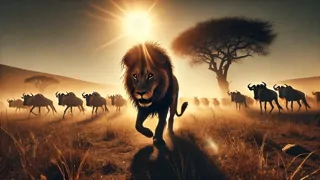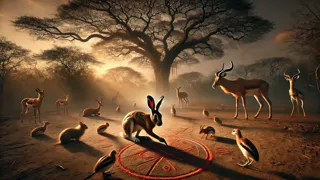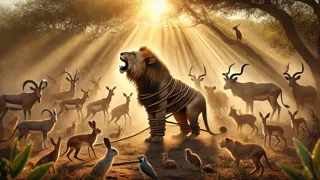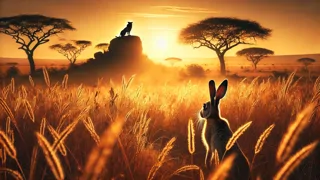Introduction
Under the endless African sky, where the horizon stretches in waves of amber grass and distant kopjes stand as silent sentinels, life once followed the careful rhythms of dawn and dusk. The plains echoed with the soft rustle of springbok grazing, the gentle call of guinea fowl, and the distant trampling of warthogs rooting for tubers beneath thirsty soil. Harmony reigned in this sunlit kingdom until the day a great lion, mane ablaze like molten gold, arrived from the northern dunes. With each thunderous roar that rolled across the grasslands, terror took root in every heart. Herds scattered, birds took flight, and even the proud eland lowered its head in deference. Under the lion’s iron rule, even waterholes became traps of fear, as any creature who dared approach found itself bound by the tyrant’s whim. In those dark days of oppression, whispers began to wind through the reeds: a small hare—a creature of swiftness and cunning—had watched this reign of terror and refused to cower. Though villagers of the grasslands had always seen the hare as a trickster of harmless mischief, now its sharp mind glowed with a fiercer purpose. It crept through moonlit shadows to secret council beneath the fever trees, listening to the wounds of the oppressed and studying the lion’s habits. With every shared tale of sorrow, the hare’s resolve grew stronger. It vowed not only to survive the king’s wrath but to dismantle his rule with nothing but wit and guile. As the sun climbed high on that fateful morning, a hush fell across the savannah. The hare, tiny against the lion’s looming power, took its first bold step. In its nimble paws, hope flickered anew for every creature that trembled in the lion’s shadow.
The Lion’s Tyranny
Beneath the sweltering midday sun, the lion’s roar became a drumbeat of dread, echoing from kopje to kopje until even the most spirited creatures trembled. He claimed every patch of shade and every pool of water as his own, marking territories with swipes of his massive claws. Gazelles once fleet of foot now hesitated at the edge of their herds, ears pinned with fear. The herds of wildebeests lamented in low moans as calves grew gaunt, too terrified to graze freely. Vultures circled overhead, not awaiting carrion but watching with morbid fascination as the lion’s shadow fell across every clearing. Parched birds fluttered among the thorn trees, reluctant to risk the journey to the riverbank. In hushed tones beneath the baobab groves, the great elephants—former pillars of strength—bowed their heavy heads. Their trumpets of pain became whispers of desperation. Nightfall offered no refuge: under a bruised sky, the lion prowled by moonlight, eyes smoldering embers in the grass. When he found an antelope grazing too close, his leap was a bolt of thunder and his jaws clamped shut like an iron trap. The anguished thrashing that followed held the breath of every listening soul. Order crumbled and kindness withered. Even the mischievous jackals kept silent, slinking from shadow to shadow, terrified to break the lion’s decree. It was in this season of terror that the hare, small yet sharp, felt the weight of responsibility settle on its slender shoulders. Gathering courage from the tremors of the grass beneath its paws, the hare embarked on its first secret mission: to map the lion’s patrol routes and identify the cracks within his armor. Each night, it raced along riverine shadows to observe the tyrant’s lair; each dawn, it returned to share newfound knowledge with the trembling council of animals. Despite their terror, gazelles, zebras, and even the wary buffalo began to place glimmers of faith in the hare’s bright mind. Hope—once thought extinct—found its spark again.

The Hare’s Cunning Designs
Armed with courage born of necessity, the hare convened clandestine gatherings beneath ancient fever trees, where the air was thick with the scent of healing bark. All manner of creatures—majestic eland, shy duikers, nimble dik-diks—slipped silently into the circle, drawn by the hare’s determined shine. With soft, confident voice, the hare outlined the tyrant’s weaknesses: arrogance, impatience, and a belief that size alone ensured victory. While the lion basked on sun-scorched rocks, he dawdled in self-importance, leaving his flank unguarded. While he slept in midday shade, his pride fell into languid slumber. It was there, in those hushed councils, that the hare sketched its plan with lines drawn in dust and chalk, reaffirming the bond between predator and prey, hero and hopeful. It called for unity in small acts of defiance: distract the lion’s scouts by sending flocks of weaver birds to chatter at dawn, close enough to rouse his fury but distant enough to protect themselves. It urged the nimble monkeys to slacken the suspension vines above the lion’s favorite ambush spot, ensuring a sudden tumble when he leapt after unsuspecting quarry. It enlisted the tortoises to roll thorny branches into the main hunting paths, turning them into labyrinths of irritation. Most cunningly, the hare proposed a riddle contest: under the pretense of entertainment, creatures from every corner of the plains would gather at the lion’s lair. Amid laughter and applause, they would close ranks, surrounding the lion once his pride lowered its guard. At this moment, the hare would present a cleverly disguised snare fashioned from braided grasses and vines, ensnaring the mighty king in a trap of its own making. That night, when the moon hung silent and waxen low, every animal pledged its skill. Though fear still pulsed in their veins, trust in the hare’s bright promise outshone dread. Their whispered oaths echoed in the hush of the grass as the greatest test of unity and wit took root.

The Great Confrontation
The dawn of reckoning arrived on a shimmering morning, the sky awash with copper light as though the sun itself prepared to witness a moment of momentous change. From every corner of the savannah, creatures converged upon a clearing carved by the lion’s past hunts. Vibrant hornbills perched in flowering acacias, their calls weaving a tapestry of sound. Agile mongoose darted along the ground, half-hidden in tufts of grass. Even the normally solitary pangolins emerged, their armored scales glinting. At the heart of this swelling throng stood the hare, chest lifted in quiet pride, eyes bright with determination. The lion arrived in stately fashion, mane swirling like dark smoke, nostrils flared at the scent of an assembled challenge. With regal stride he entered the clearing and let out a roar meant to scatter hopes. Instead, he found himself greeted by a hush of defiance. The hare stepped forward, nibbling the edge of its whiskers, and issued its challenge: a contest of riddles to prove the worth of mind over might. Intrigued by the audacity, the lion settled upon a fallen log, mane rippling like a banner caught in a breeze. The contest began with simple puzzles, demanding only sharp senses and quick wits. As each riddle fell before the assembled crowd, the lion answered with growing confidence. Then came the final challenge, whispered by the hare yet designed to turn the king’s pride inward: “What holds the world and carries the sky but cannot be lifted by even the strongest claw?” The lion’s amber eyes narrowed as he paced the log’s length. Pride stuttered beneath his ribcage; arrogance faltered beneath the weight of a question that sought the very nature of power. Meanwhile, the assembled animals enacted the hare’s hidden trap. Monkeys released vines, scattering the lion’s guards; tortoises rolled thorny barricades with silent resolve; birds swooped low, drawing every head upward and away from the clearing’s center. Before the lion could conquer the riddle or call upon his strength, the braided vines slipped beneath his paws, tightening each moment. He roared in fury and frustration, but every struggle only bound him faster. Husks of fear crumbled into dust as the animals closed ranks, not to harm but to correct the savage imbalance that had ruled them. At last, panting and humbled, the lion lowered his head within the greatest cage he could command: his own restraint.

Conclusion
As silence fell over the humbled monarch, the savannah seemed to exhale for the first time in countless moons. With careful strokes of its paw, the hare unwound the braided ropes that bound the lion’s prideful limbs, offering mercy where cruelty once reigned. The great king, stripped of arrogance and confronted by the unity of those he oppressed, bowed his massive head and felt the flicker of regret. In that moment, the animals saw not a tyrant but a creature capable of change. Under the hare’s wise counsel, the lion vowed to abandon fear as his weapon and to protect the plains rather than terrorize them. Rivers of relief washed through the herds of antelope, the flocks of birds, and even the watchful cheetahs—all creatures who had learned that wisdom and compassion could outmatch brute force. From the tallest giraffe nibbling tender shoots on ancient acacias to the shy porcupine retreating into ferny undergrowth, each being emerged with a renewed faith in possibility. The hare, its heart alight with hope, watched the lion stride back into his rightful role as guardian of the grasslands. As peace returned like rain to parched earth, the lesson settled deep within every soul: size and strength may rule the moment, but cleverness, kindness, and unity govern the ages. And so the legend of the hare and the lion passed on, whispered on the wind beneath the African sky, a timeless reminder that courage of mind can change even the greatest hearts.

















